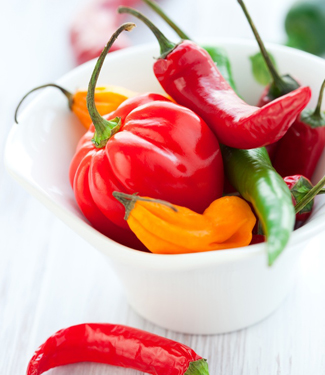Whether chopped and whirred into a fresh salsa, slowly sautéed with onions and garlic, stuffed with well-seasoned picadillo, or charred to the point of collapse, fresh peppers stand apart in any dish. From sweet and fleshy bell peppers to fiery habaneros, the range of colors and flavors can be overwhelming – and that’s before they are smoked and dried for days. With wildly varying degrees of heat, nothing matches them for versatility and brightness. Who can resist playing with fire? Here are just a few favorites to get started:
Ajíes/Bell Peppers
More supermarket than farmer’s market, green bell peppers, relatively mild and workman-like, are easy to overlook. They don’t offer heat or complexity, but sofritos of chopped ajies verdes and onions are at the heart of traditional Caribbean cooking. Their sweeter red counterparts, whether roasted and preserved as pimientos or ground into prized pimentón, often steal the show. In any color, bell peppers are an excellent source of Vitamin C and other nutrients.
Ají Amarillo/Yellow Chile Pepper
Also known as ají escabeche, these deep orange, canoe shaped peppers from the Andes are more sun than fire. Aromatic and fruity, they bring a delicate but steady heat to Peruvian causas and well-loved recipes like salsa a la huancaína. Until recently, they were sold mostly as concentrated pastes or preserved and brined, but are increasingly available frozen in well-stocked Latin American markets. Dried, it’s called ají mirasol and can be used whole or ground into a powder.
Habanero
These small, bell shaped peppers, ranging from grassy green to delicate yellow to deep orange, would be cute if they weren’t so mean. The habanero’s pungency clocks in at 80,000-150,000 Scoville Heat Units so they should be handled carefully. Bright and tropical with delicate citrus notes, they work well in fresh salsas and marinades. To moderate the heat, soak them in milk before using. In West Indian cooking, habaneros can be substituted for the gentler Scotch bonnet.
Jalapeño
Jalapeños are perhaps the best known of Mexico’s fresh chili peppers, getting their name from the city of Xalapa (or Jalapa), the capital of Veracruz. Ranging from green to red, they can be used in a wide variety of South American recipes like Chilean pebre or Ecuadorian ají criollo. As in other peppers, the degree of heat is determined by the amount of capsaicin present in the spongy interior fibers where the seeds attach themselves to the inner walls. Removing the seeds and veins before using will tame the heat, but why would you want to?
Poblano
These mild peppers from Puebla, are the perfect blank slate. Charred and roasted, the skin peels away to reveal a meltingly sweet, deep green flesh that can be sliced into rajas (strips) then sauteéd, added to a spicy tomato broth, or lightly dressed and served on its own. Perfect for stuffing, they hold their shape easily after roasting. Over-ripe, they lose pungency and much of their flavor so look for ones with smooth and plump skin.


![Making Mealtime Matter with La Familia: Easy Sofrito [Video]](https://thelatinkitchen.com/wp-content/uploads/2015/10/sofrito-shutterstock__0-500x383.jpg)
![Easy Latin Smoothies: Goji Berry Smoothie [Video]](https://thelatinkitchen.com/wp-content/uploads/2015/12/goji_berry-shutterstock_-500x383.jpg)
















![Fun and Fast Recipes: Fiesta Cabbage Salad [Video]](https://thelatinkitchen.com/wp-content/uploads/2015/11/fiesta_cabbage_slaw-shutterstock_-500x383.jpg)









